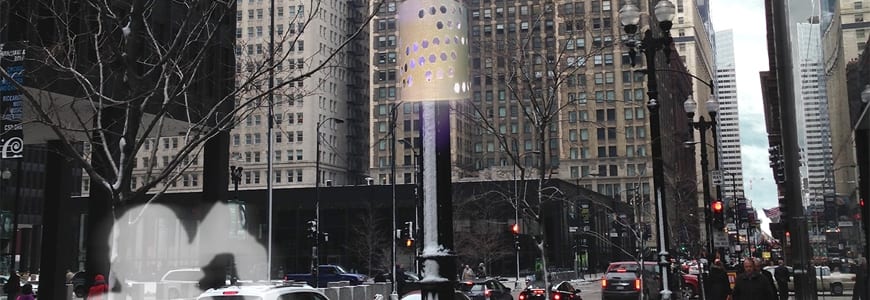By Rob Mitchum // June 23, 2014
The open release of city data has given residents exciting new ways of interacting with and benefiting from the information collected by city agencies. But what if there was a way to collect even broader, higher-resolution data on the daily life of the city, providing a massive stream of open data for research and the development of new applications to improve urban life? The Array of Things is a project of the CI’s Urban Center for Computation and Data (UrbanCCD) to deploy interactive, modular sensor boxes around Chicago to collect real-time data on the city’s environment, infrastructure, and motion for research and public use. While the first nodes won’t be installed along Michigan Avenue until later this summer, the media has seized upon the idea as an exciting new way of “instrumenting” a city for the greater good.
In a column for Bloomberg View, writer Susan Crawford talks about the potential for this “game-changing” network, which will collect data on environmental factors, infrastructure, and pedestrian traffic. Crawford also highlights how the Array of Things is the latest in a long line of efforts that have made Chicago a leader in using data for urban research and development.
Chicago, the quintessential American city, is quickly becoming the nation’s leading city for data analytics. It has involved data scientists such as [UrbanCCD director Charlie] Catlett in its processes, pushed to open all of its data (including complete crime statistics) to the public, and begun prioritizing its inspections of stores and other businesses based on correlations between particular conditions — say, past violations or 311 complaints coming from the same location — and the likelihood of problems.
Now it’s moving to understand its weather, pollution and noise in a transparent, public-friendly way. This means that the city will be able to investigate reams of these data, combine it with other information, and make predictions about its future that inform how the city allocates its resources and changes its policies. It’s crowded? Change the traffic light patterns. Pollution is a problem in particular neighborhoods? Find out why and fix it.
Meanwhile, in the Chicago Tribune, reporter David Heinzmann takes a look at the goals of the project and how researchers are proactively addressing any possible privacy issues. While some experts cautioned about the collection of data from nearby smartphones and other network-enabled devices, Catlett emphasized that nodes will only count the number of devices in range, and will not collect or save the numerical addresses from phones, tablets, or computers. Social scientists expressed excitement about the possibilities for this new fine-grained data about the city’s environment and daily life.
While the benefits of collecting and analyzing giant sets of data from cities are somewhat speculative, there is a growing desire from academic and industrial researchers to have access to the data, said Gary King, director of the Institute for Quantitative Social Sciences at Harvard University.
“You really don’t know until you look,” King said.
While he said he was unfamiliar with the project in Chicago, King likened such projects to the early efforts of looking into deep space with the Hubble Space Telescope, opening new and unknown frontiers of information, “only the telescope is pointed downward” at life on the streets of the city.
In the wake of these pieces, other outlets covered the Array of Things as well, calling it everything from “a friendlier Big Brother” to a “fitness tracker for the city.” You can read those stories at Wired UK, Digital Trends, SiliconANGLE, Silicon Republic, Crazy Engineers, Engadget, Ubergizmo, and Slashgear.
[Artists’ rendering of an Array of Things node by Douglas Pancoast and Satya Mark Basu of the School of the Art Institute of Chicago.]

